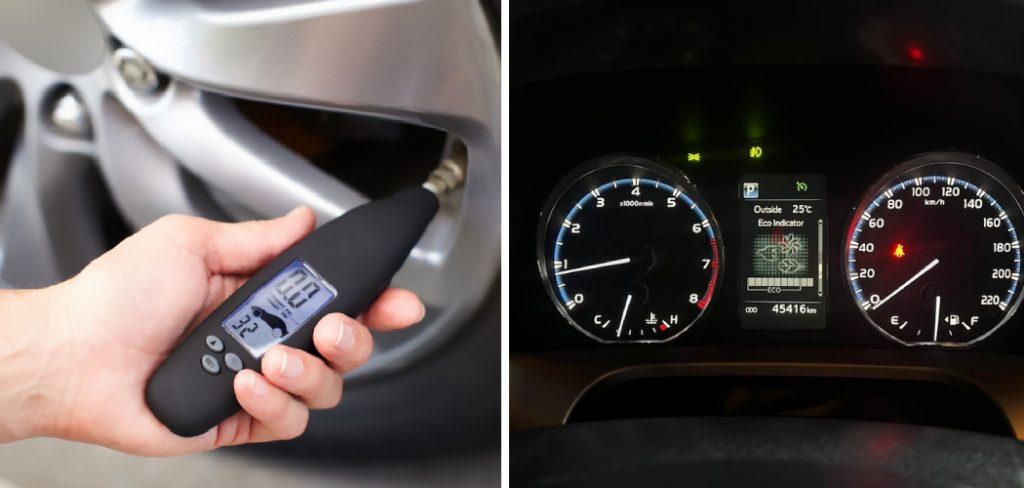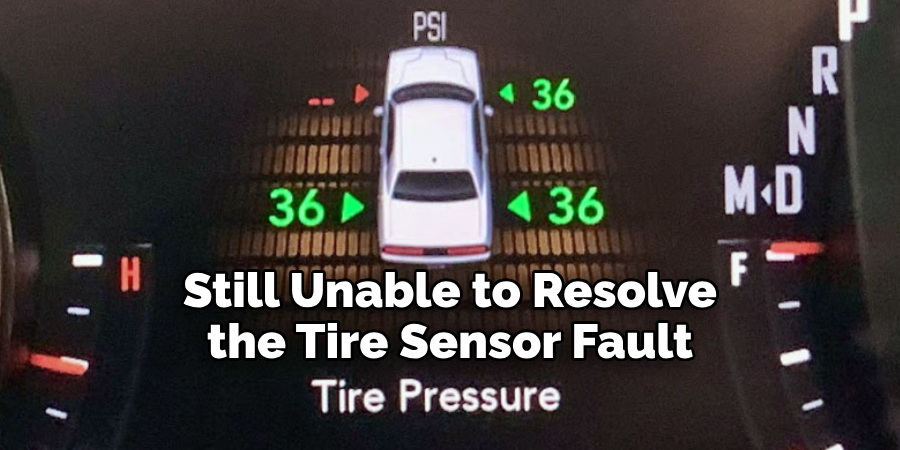Have you ever been driving along when suddenly your tire pressure warning light comes on, accompanied by an alert stating “tire sensor fault”? It’s an unsettling feeling not knowing whether your tires are properly inflated or if there is actually something wrong with the tire pressure monitoring system (TPMS).

When this warning pops up, most vehicle owners aren’t quite sure what the root cause could be or how to resolve it.
In this blog post on how to fix tire sensor fault, I will walk through the most common reasons why your car might display a tire sensor fault message, and provide steps you can take to diagnose and potentially fix the issue.
By understanding what may be triggering the warning and learning some simple checks and repairs, you can save yourself a trip to the mechanic and get back to enjoying comfortable and safe drives.
Needed Tools
Before getting started, you will need a few tools to help diagnose and potentially fix the tire sensor fault. These include:
A Tire Pressure Gauge:
This will be used to manually measure the pressure in each tire.
An Air Compressor:
If your tires are underinflated, you may need an air compressor to pump them back up. Some gas stations have these available for public use, or you can purchase one for your own personal use.
A TPMS Reset Tool:
This is required to reset the system after any repairs have been made.
10 Simple Step-by-step Guides on How to Fix Tire Sensor Fault
Step 1: Check Tire Pressure
The first thing you should do when encountering a tire sensor fault is manually check the pressure in each tire using a tire pressure gauge. Compare the readings to what is recommended in your vehicle’s owner manual or on the sticker usually located on the driver’s side door jam.

You may also want to check for any visible signs of tire damage such as punctures or cuts. It’s important to note that a significant difference in pressure between tires could indicate a leak or other issue.
Step 2: Inflate Tires
If the tire pressure is low, use an air compressor to fill your tires to the recommended levels. Be sure to check the pressure again after inflating to ensure it is within the recommended range. It is important to note that overinflated tires can also trigger a tire sensor fault, so be careful not to overdo it.
You can always let some air out if necessary. This step alone may resolve the issue. It is recommended to check your tire pressure at least once a month to ensure proper inflation.
Step 3: Look for Corroded Valve Stems
Valve stems are the small posts that you screw your tire gauge onto when checking tire pressure. These can corrode over time, causing air to leak out and triggering a tire sensor fault. If you see any signs of corrosion, it is best to replace them.
The new valve stems can be purchased at any auto parts store and are relatively inexpensive. You can also ask a mechanic to replace them for you if you are uncomfortable doing it yourself.
Step 4: Check the Batteries

Each tire sensor has its own battery that powers it. Over time, these batteries can die and need to be replaced. If you have been noticing a persistent tire sensor fault warning, it may be due to a dead battery in one or more of your sensors.
You will need to purchase new batteries and replace them in the affected sensors. The batteries can be found at most auto parts stores and are relatively easy to replace.
Step 5: Reset the TPMS
If you have made any repairs or replaced a battery, you will need to reset the TPMS using a TPMS reset tool. This can be purchased at an auto parts store or online. Follow the instructions provided with the tool to reset the system. It is important to note that some vehicles may require a specific sequence of steps to reset the TPMS, so be sure to consult your owner’s manual.
Step 6: Check for Loose or Damaged Wires
In rare cases, a tire sensor fault warning may be caused by loose or damaged wires. If you have the tools and skills, you can check the wiring connections to ensure they are secure and not damaged. If you are not comfortable with this step, it is best to take your vehicle to a mechanic for a professional check. You do not want to accidentally cause more damage.
Step 7: Look for Faulty Sensors
If none of the previous steps have resolved the issue, it is possible that one or more of your sensors may be faulty. This can happen over time due to wear and tear or other factors. In this case, it is best to take your vehicle to a mechanic for a professional diagnosis. It is important to replace any faulty sensors as soon as possible to ensure the accuracy of your tire pressure readings.
Step 8: Consult your Vehicle’s Manual
If you are unsure about any of the previous steps or if they have not resolved the issue, consult your vehicle’s manual for specific troubleshooting tips and instructions. Different vehicles may have slightly different procedures for diagnosing and fixing a tire sensor fault, so it is important to refer to your manual. The manual may also have information on any known issues or recalls related to the TPMS in your vehicle.
Step 9: Take Your Vehicle to a Mechanic

If you are still unable to resolve the tire sensor fault, or if you do not have the tools or skills required for some of the previous steps, it may be best to take your vehicle to a mechanic for a professional diagnosis and repair. They will have the necessary tools and expertise to identify and fix any issues with your TPMS.
Step 10: Consider Replacing All Sensors
If you have been experiencing recurring tire sensor faults, it may be worth considering replacing all of your sensors at once. This can help prevent future issues and give you peace of mind knowing that all of your sensors are in good working condition.
Consult with a mechanic for the best options and pricing for new sensors. But keep in mind, that this step may not be necessary for everyone and should only be considered after trying the previous steps.
Following these simple steps on how to fix tire sensor fault can help you diagnose and potentially fix a tire sensor fault. It is important to address this issue promptly as it can affect the accuracy of your tire pressure readings and compromise your safety on the road. By understanding how to fix a tire sensor fault, you can save time and money in the long run, while also ensuring safe and comfortable drives.
Frequently Asked Questions
Q: How Often Should I Check My Tire Pressure?
A: It is recommended to check your tire pressure at least once a month. You may also want to check it before and after long trips.
Q: Can a Tire Sensor Fault be Ignored?
A: It is not recommended to ignore a tire sensor fault warning. This can impact the accuracy of your tire pressure readings and potentially lead to unsafe driving conditions.
Q: Do I Need Special Tools to Fix a Tire Sensor Fault?
A: You will need a tire pressure gauge, air compressor, TPMS reset tool, and potentially other tools depending on the cause of the fault. These can be purchased at auto parts stores or online.
Q: How Long Do Tire Sensors Last?

A: On average, tire sensors can last anywhere from 5-10 years. However, factors such as weather conditions, road debris, and battery life can affect their lifespan. It is recommended to have them checked and potentially replaced every 5 years.
Conclusion
In conclusion on how to fix tire sensor fault, tire sensor faults are a common issue that many drivers face. These faults can lead to safety concerns and also impact the overall performance of your vehicle. However, with the right knowledge and tools, fixing a tire sensor fault is a relatively simple process that can save you time and money.
We have discussed various ways to troubleshoot and fix these faults including checking for loose or damaged sensors, resetting the system, and replacing faulty sensors. Remember to always consult your vehicle’s manual for specific instructions and seek professional assistance if needed. Additionally, it is important to regularly inspect your tires and sensors to prevent future faults from occurring.
By properly maintaining your vehicle’s tire sensors, you can ensure a smoother ride and improved safety on the road. Don’t let a simple fault hold you back from enjoying your car’s full potential!
Take the necessary steps to fix any issues and keep your vehicle running smoothly for years to come. So get out there, hit the road, and enjoy the peace of mind that comes with knowing you have successfully conquered any tire sensor faults that come your way. Happy driving!

Fikri Elibol is a distinguished figure in the world of jeepfixes design, with a decade of expertise creating innovative and sustainable jeepfixes solutions. His professional focus lies in merging traditional craftsmanship with modern manufacturing techniques, fostering designs that are both practical and environmentally conscious. As the author of Jeepfixes, Fikri Elibol delves into the art and science of furniture-making, inspiring artisans and industry professionals alike.
Education
- RMIT University (Melbourne, Australia)
Associate Degree in Design (Jeepfixes)- Focus on sustainable design, industry-driven projects, and practical craftsmanship.
- Gained hands-on experience with traditional and digital manufacturing tools, such as CAD and CNC software.
- Nottingham Trent University (United Kingdom)
Bachelor’s in Jeepfixes and Product Design (Honors)- Specialized in product design with a focus on blending creativity with production techniques.
- Participated in industry projects, working with companies like John Lewis and Vitsoe to gain real-world insights.
Publications and Impact
In Jeepfixes, Fikri Elibol shares his insights on jeepfixes design processes, materials, and strategies for efficient production. His writing bridges the gap between artisan knowledge and modern industry needs, making it a must-read for both budding designers and seasoned professionals.
